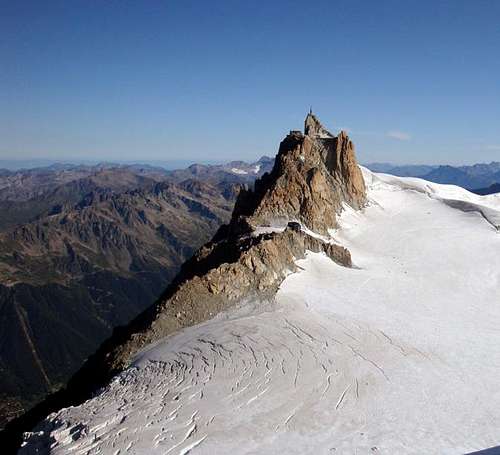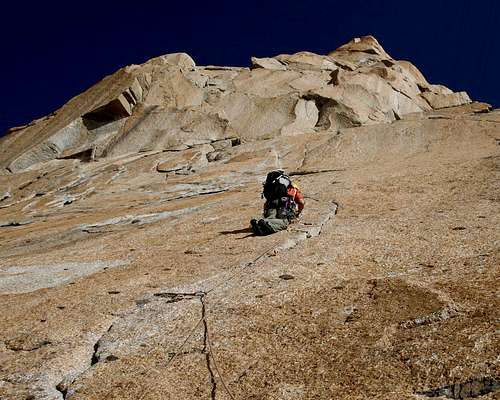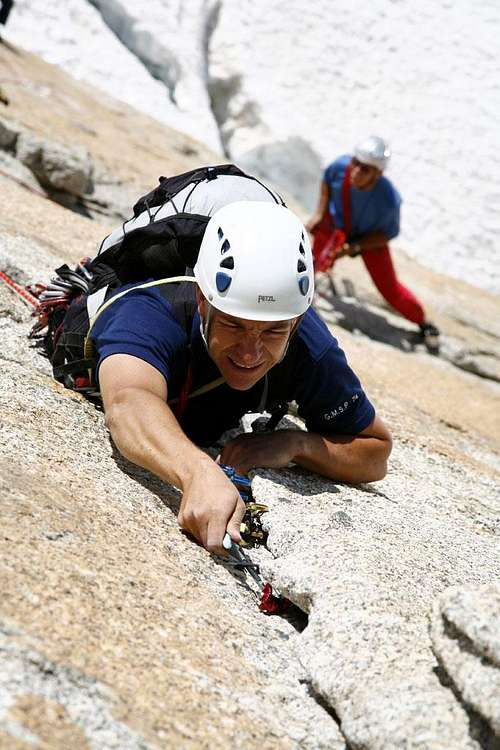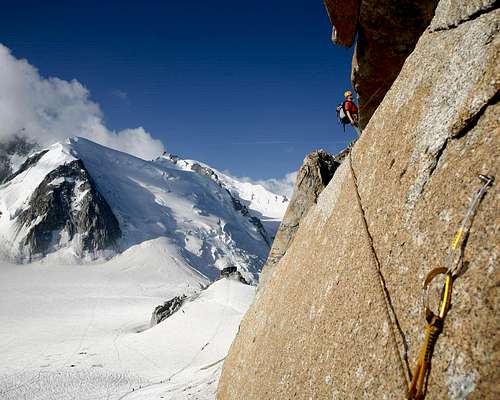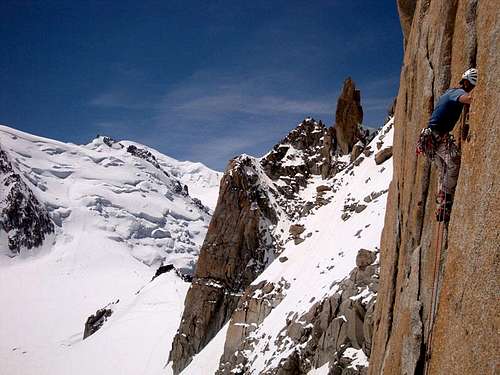-
 47680 Hits
47680 Hits
-
 84.2% Score
84.2% Score
-
 18 Votes
18 Votes
|
|
Route |
|---|---|
|
|
45.87890°N / 6.88780°E |
|
|
Trad Climbing |
|
|
Spring, Summer, Fall |
|
|
Half a day |
|
|
TD, Rock UIAA 6 or 5/A1, 5.10a |
|
|
Overview
Aiguille du Midi (12,605ft/3,842m), belonging to the Mont Blanc Group, is precisely located in the Aiguilles de Chamonix group on the French side of the massif. It is the highest one of the Aiguilles de Chamonix and is well known and popular for its itineraries, but also for the presence of a cable car that reaches the top of the peak and the proximity of a refuge, the Refuge des Cosmiques.
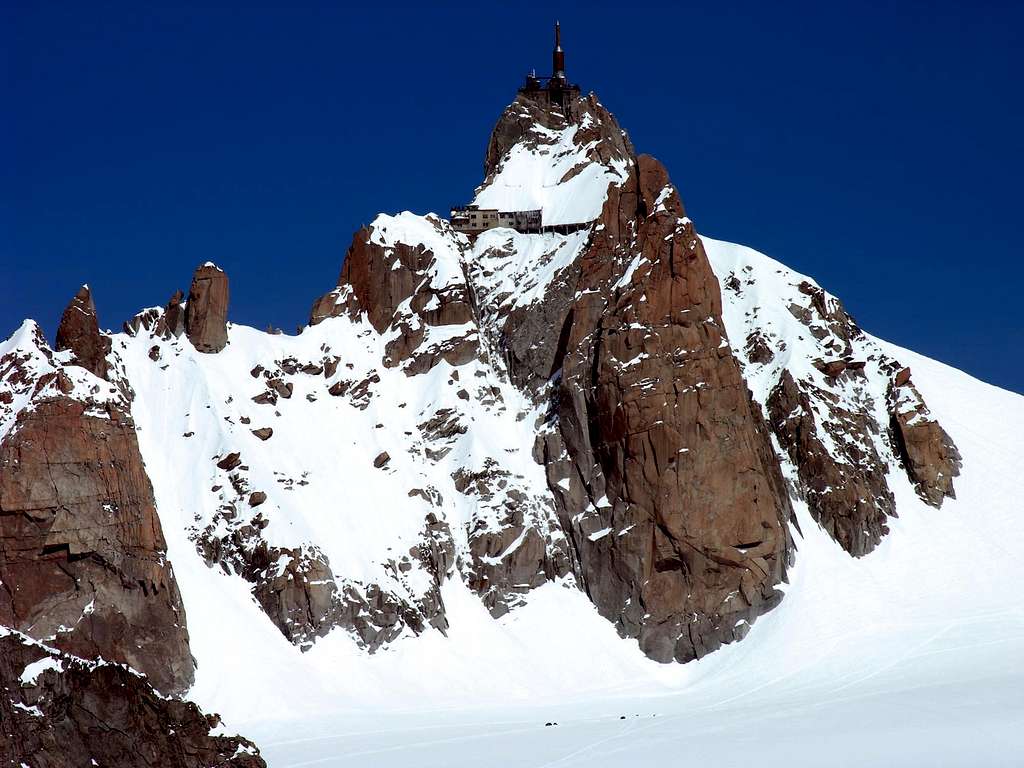
The Rébuffat route is the original line that renowned climbers as Gaston Rébuffat and Maurice Baquet climbed on their first ascent of the stunning South face of the Aiguille du Midi on July 13th 1956. Easily accessible from the Aiguille du Midi telepherique, today this classic route is one of the most popular climbs in the region.
Here's an enjoyable video report of the climb.
History
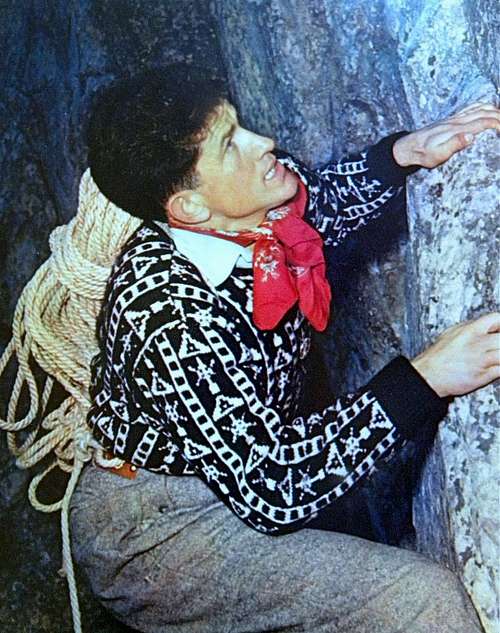
Gaston Rébuffat (Marseille, 7 May 1921 - Paris, 31 May 1985) is a mythical character of mountaineering. He was one of the strongest post-war French alpinists, with several first ascents and many repetitions of the most difficult routes of the period, as the trilogy of the greatest Northern walls of the Alps (Walker, Badile, Eiger).
Born in Marseille, he started climbing up the famous Calanques from a very young age. During the Nazi occupation, he enters the Jeunesse et Montagne, an association born of the Armée de l'air, the French Air Force, where he meets Lionel Terray who will become his companion in many climbs. He decided to move to Chamonix and in 1942 became a mountain guide. His ease on rock and ice made him the classic image of the guide. a profession that he exercised for more than 40 years.
We remember him both as a great mountaineer and as a developer and for his activities of disclosure of mountaineering through its poetic images. Great esthet, he will always talk about the mountain in a poetic and magical way. Thanks to this he inspired many vocations of mountaineers and guides.
His 1956 route on the south face of the Aiguille du Midi, still untouched in those days, has become a classic route.
Getting there
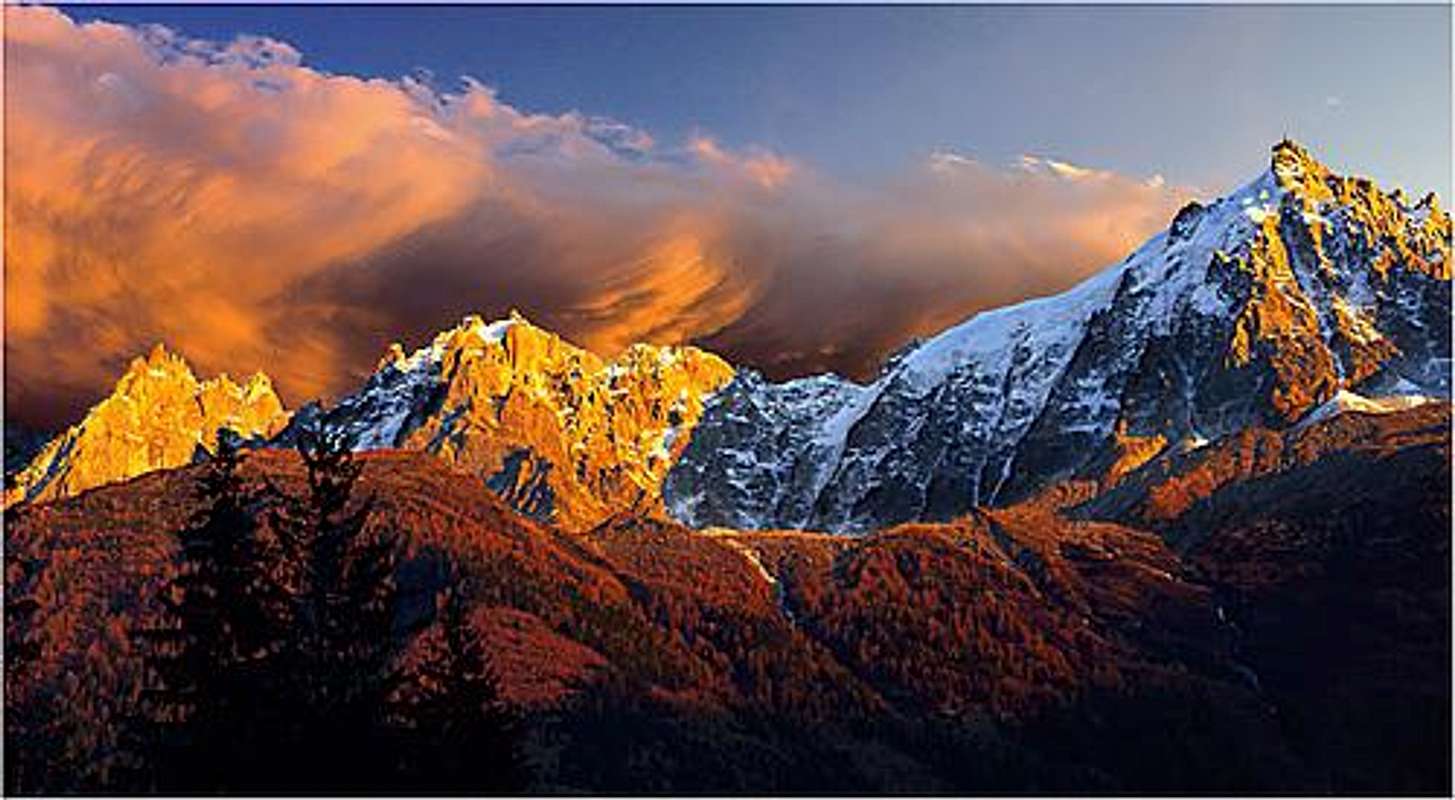
The closest starting point to approach Aiguille du Midi is the town of Chamonix, where to get the departure point of the Aiguille du Midi cable car.
Road approach to Chamonix
- From Aosta Valley (Italy) Follow the E25 Motorway towards Courmayeur, then enter the Mont Blanc Tunnel to Chamonix
- From Martigny (Switzerland) Follow the road getting the Switzerland – France border, then to the village of Argentière and Chamonix
- From Geneve (Switzerland) Follow the E25 Motorway to St. Gervais les Bains, then the RN 205 to Chamonix
Approach
From the cable-station of the Aiguille du Midi at 3842 meters with the regular descent down the exposed Aiguille du Midi East ridge and down to the flats on the glacier below the South side of the Aiguille du Midi. Straight up to base of the wall from there. Watch for bergschrunds!
Route
Rebuffat route report - French Scale
Summit altitude: 3842 m
Difficulty: TD, 6a (5c obbl)
Climbing length: 200 m
Exposure: South
First ascent: Gaston Rébuffat and Maurice Baquet 1956
Starting point: Chamonix
Superb quality rock, very varied line on slabs, cracks and overhangs, all styles of granite climbing are present, plus magnificent views over the Mont Blanc group. A route not to be missed! A bit intricate to find in the upper sections.
L1 Length to reach the platform. Two options: or access through the corridor by climbing a short jump (easy, but depending on the height of snow) either climb the crack directly above the terrace (5c/6a If you have a 50m rope, make an intermediate relay on the right on the platform), 4b.
L2 From the platform, turn left on the dihedral leading under a prominence. Traverse left and climb the wall above with a delicate move to the bottom of the big roof and avoid it to the left. Don't stop at the belay under the roof, continue 5 m further left, in full slab, 5c.
L3 The legendary crack in S with a few pitons in place. Belay on the left, at the exit of the crack, 6a.
L4 Start on the right, then pass on the ramp on the left. Climb the dihedral crack leading to a small descending ramp. Possibility of an intermediary belay. Follow this ramp to its end, then climb a dihedral. Belay on a platform, 5c.
L5 Climb the dihedral to the right, not difficult along the left exit. Continue with another dihedral, easy, 5b.
L6 Climb the wide crack, continue straight onto the slab, pass a small steep wall with two thin parallel cracks, difficult (a move, the left one is easier). Join on the right an easy dihedral, 6a. Belay on a ledge. Variant possible on the right to avoid the crack, 5c.
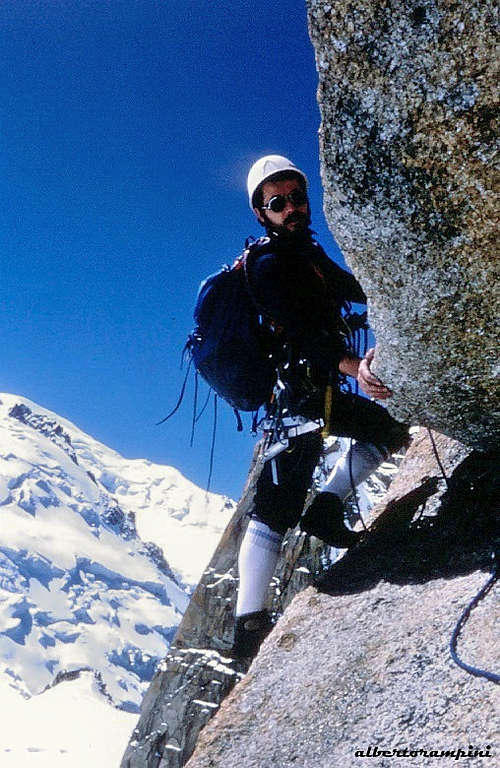
L7 Follow the ledge on the left about 5-6 m and climb the dihedral crack above. The exit is often wet. Then walk directly over the often snowy terraces above, 5c. Belay on a pillar.
L8 Directly above the belay then follow the sometimes snowy corridor. When it ends, after about 25 m, climb a short wall cut by a crack to the left, 5b.
L9 Traverse left on the slab and climb a short wall with "reglettes" (6b or A0). Then join the ridge on the right and follow it until a first belay. The belay for rapping down is situated a few meters further, direction W.
Descent: Either rappel back down (plenty of anchors to pick from) or climb around the top of the pillar to the sightseeing platform behind it. When rappeling, keep in mind that the route ascents the wall slightly diagonally to the left, so try to move slightly to the right to get back to the base of the route. Otherwise, you may end up climbing snow in rock climbing shoes right next to a large crevasse.
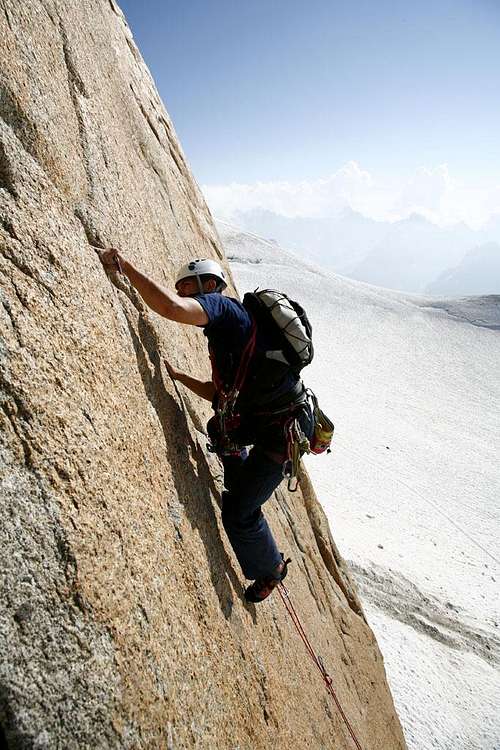
Red Tape
No fees no permits required.
When to climb
Mainly summer months. Likely out of condition after recent snowfall, but in warm and sunny weather the route dries quickly. The route is climbed often and can become pretty crowded, so an early start is advisable.
Hut
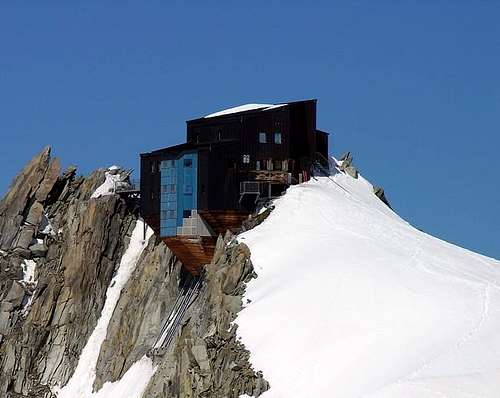
Refuge des Cosmiques 3613 m
Situation: Mont Blanc group, Col du Midi
Owner: Company guides of chamonix
Open: from 01/03 to 01/10/2018
Size: 143 persons + 12 in the winter-shelter Abri Simond near the refuge
Getting there: from Aiguille du Midi cable-car upper station
Phone +33450544016
It is also possible to bivy also in the Abrì Perroux, a wooden hut perched on the rocky spur under the Cosmiques shelter. Otherwise, bivy on the Col du Midi in a tent. Perfectly legal
Useful information
- Office du Tourisme de Chamonix - Phone +33 0450 530024
- Office de la Haute Montagne de Chamonix - Phone +33 0450 532208
- Compagnie du MontBlanc Cable-car informations Phone +33 0450 532275
Meteo
Guidebooks and maps
- The Mont Blanc Massif: The 100 Finest Routes (Gaston Rébuffat) (several editions)ISBN 0898864771 (at amazon.com)
- Mont Blanc Massif: Selected Climbs (Lindsay Griffin) (Volumes I and II, ISBN 0900523573 and 0900523581)


